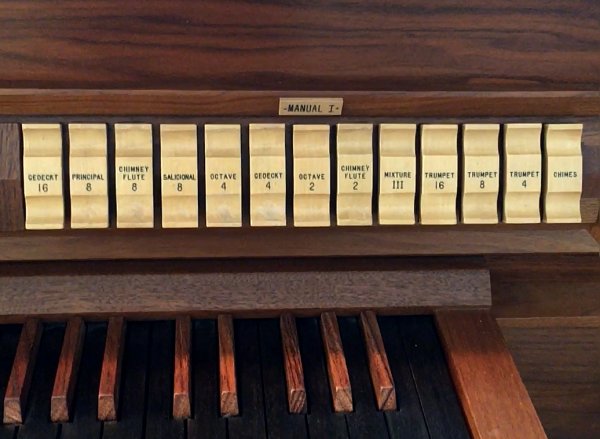Organist at House of Prayer Lutheran

Henry at the 1989 Schlicker two-manual and pedal organ at House of Prayer Lutheran Church, Escondido.
February 1, 2017: Henry Doktorski began working at House of Prayer Lutheran Church in Escondido, California, as their organist and accompanist. Music Director Carol Gross announced in the February 2017 issue of the church’s monthly journal, Glad Tidings: “It is my privilege to share with you some joyous news! It is with great pleasure that I announce that we have a new organist joining us! Henry Doktorski . . . is extremely qualified and a fantastic addition to our music ministry! Welcome Henry! We are blessed to have you joining us, and I look forward to working with you.”
In a letter to the congregation published in the same journal, Henry explained, “I am thrilled that Pastor Dr. Daren Erisman, Music Director Carol Gross, and the House of Prayer Search Committee asked me to be your new Organist/Accompanist! I thoroughly enjoyed my Interview/Audition on January 16, for several reasons, one of which is that your 1989 Schlicker two-manual and pedal organ is GORGEOUS! and so well-maintained! It was a real treat for me to play such a beautiful instrument with such a varied palate of timbres and tone colors. Wow! I had so much fun. I hope you will be pleased with my humble attempt to provide music to help support the messages of the Sunday Readings, the Pastor’s Sermons, and the choir anthems and hymns selections chosen by your Director of Music, and in my small way, to help provide a moving and spiritual experience for everyone. In all humility, I thank you for accepting me into your family, and I pray to serve you to the best of my abilities.”
Henry mused on his first year in California:
“It’s been almost exactly one year since I arrived in California on January 30, 2016, and I feel that now things are starting to fall into place for me. Yes, I had a wonderful first year: I served as guest organist for a dozen churches, and often I was quite busy playing for Saturday Masses, Sunday Services, and funerals during the week; I was hired as Rotating Organist (alternate Saturdays) by St. Martha Roman Catholic Church in Murrieta (I’m a regular employee now); I played organ in recitals in San Diego and Orange counties; and I was appointed as a Board Member for the Palomar Chapter of the American Guild of Organists, but now that I have a permanent position playing a beautiful organ in a beautiful church with beautiful staff and clergy (in addition to being hired in January as Coordinator for Educational Programs by the Temecula Chess Club), my life has achieved a greater measure of stability and security.
“I suppose moving to California without any guarantee of employment was a big leap of faith, but depending on Providence is not something foreign to me. Every day we take risks and sometimes we take big risks; but at the time (January 2016) I knew in my heart that it was time for a change. I felt Fate was pushing me out of Pennsylvania and into a new adventure. I find it serendipitous that when I came here I predicted that I would find full employment in a year. The year has passed, and my prophesy has materialized, almost to the day! I am grateful for everything and I thank my friends and family for their support.”
To hear Henry play the 1989 two-manual and pedal Schlicker organ at House of Prayer Lutheran, click here.

The organ has 36 stops representing nine ranks of pipes: Principal, Gedeckt, Chimney Flute,
Salicional, Salicional Celeste, Mixture III, and Trumpet; plus Chimes and Zimbelstern.

The instrument is beautiful visually as well as aurally.

The “white” keys of the two 60-note manuals are made from ebony and the “black” keys are made from rosewood.

The “white” keys in the 32-note pedalboard are maple and the “black” keys are walnut.

The stops for the pedals.

The stops for Manual II.

The stops for Manual I.

The facade contains speaking pipes; the Principal pipes.

The Gedeckt, Chimney Flute, Salicional, Salicional Celeste, Mixture III and Trumpet pipes, as well as the Chimes and Zimbelstern, are located inside or behind the cabinet.